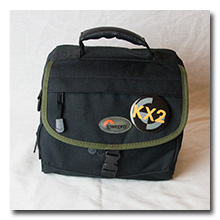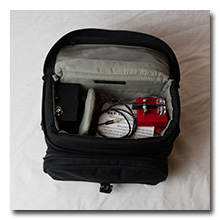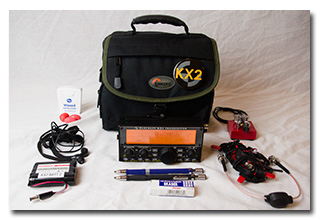by William Eric McFadden
The KX2 Mini Travel Kit is a small but complete low-power, all-mode, HF station in a rugged and weather-resistant LowePro Nova 1 camera bag. The KX2 Mini Travel Kit is designed for transport by bicycle or foot.
The KX2 Mini Travel Kit is currently under development. Photos may not represent the current state of the station. This page will change as various ideas are tested and accepted or rejected.
-
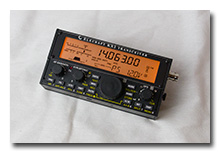 The heart of the KX2 Mini Travel Kit is an Elecraft KX2
low-power transceiver equipped with the KXBT2 internal Li-ion battery and the
KXAT2 Internal Automatic Antenna Tuner.
The heart of the KX2 Mini Travel Kit is an Elecraft KX2
low-power transceiver equipped with the KXBT2 internal Li-ion battery and the
KXAT2 Internal Automatic Antenna Tuner.
The trail-friendly KX2's all-band (80-10m) coverage, all-mode (CW/SSB/AM/FM/data) capability, competition-grade receiver, truly generous feature-mix, extremely small size, extremely low weight, and outstanding battery-friendly design make the KX2 a truly extraordinary field-radio.
-
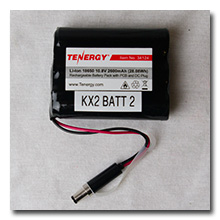 The KX2 is designed to operate using an internal 2.6Ah, 11v Li-ion battery,
the KXBT2. I have two of these batteries, and the pair of them should power
the KX2 for several hours of heavy use.
The KX2 is designed to operate using an internal 2.6Ah, 11v Li-ion battery,
the KXBT2. I have two of these batteries, and the pair of them should power
the KX2 for several hours of heavy use.
My KX2 is not equipped with the recently-released KXIBC2 Internal Battery Charger, so my KXBT2 battery must be removed from the KX2 during charging.
The KX2 is equipped with an external DC socket and, if necessary, I can power the radio with an external Talentcell Li-ion battery or with any of my Bioenno LiFePO4 batteries.
-
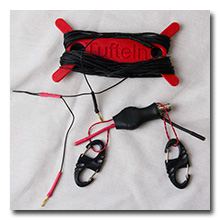 The KX2 Mini Travel Kit includes a Tufteln (link)
End-Fed Random Wire (EFRW) antenna (which comes with a 9:1 transformer, a 35' radiator, and a
single 17' counterpoise wire), and a Tufteln 12" RG-316 BNC Common-Mode Choke. The antenna and
common-mode choke were unexpectedly given to me by the builder, Joshua Ellis, N5FY, at Hamvention
2023 via Thomas Witherspoon, K4SWL. The antenna system packs up very small, is very rugged, and
is full of really clever engineering—it's clear that Joshua has put a great deal of thought
into the design of this antenna.
The KX2 Mini Travel Kit includes a Tufteln (link)
End-Fed Random Wire (EFRW) antenna (which comes with a 9:1 transformer, a 35' radiator, and a
single 17' counterpoise wire), and a Tufteln 12" RG-316 BNC Common-Mode Choke. The antenna and
common-mode choke were unexpectedly given to me by the builder, Joshua Ellis, N5FY, at Hamvention
2023 via Thomas Witherspoon, K4SWL. The antenna system packs up very small, is very rugged, and
is full of really clever engineering—it's clear that Joshua has put a great deal of thought
into the design of this antenna.
I pretty quickly purchased a Tufteln Antenna Counterpoise Add-On Kit to use with the Tufteln EFRW antenna. This kit consists of two additional 17' counterpoise wires on a winder and a one-to-three adapter cable to allow connection of up to three counterpoise wires to the 9:1 transformer instead of just one. When afield, I deploy three counterpoise wires when I safely can in an attempt to reduce ground-losses. However, I have found the 35' EFRW to be an effective antenna even when only one or two counterpoise wires are deployed.
In May of 2025, I built a 29' radiator and a 58' radiator to supplement the Tufteln EFRW antenna. Either of these would be used with the Tufteln EFRW 9:1 transformer and 17' counterpoise wires in place of the original 35' wire. The 29' wire allows me to deploy the antenna as a true vertical on a 33' Jackite telescoping fiberglass mast, and the 58' wire should provide better performance on 40, 60, and 80m than either the 29' or the 35' radiator would provide. I've verified that the KX2's internal ATU can match the 29' wire deployed as a vertical on all bands from 40 to 10m, and I've verified that the KX2's internal ATU can match the 58' wire deployed as a sloper on all bands from 80m to 10m, although it struggles on 60m.
In case the Tufteln 9:1 transformer were to fail in the field, I carry a BNC-to-binding-post adapter; this would allow me to connect a radiator and counterpoise wires directly to the KX2's BNC antenna jack.
Since I don't like to fuss with throwing a line through trees to support an antenna, I usually use an inexpensive but lightweight and rugged Goture Red Fox Super Hard 720 carbon-fiber telescoping fishing pole that I can strap vertically to my bicycle, bungie to an existing post, or support on a spike stuck into the ground, and deploy my antenna on the mast as a sloper or as an inverted-vee. I have removed the top three sections from the Goture Red Fox Super Hard 720 because they're much too whippy to support a wire, making an honest 18' 3½" mast. The Goture Red Fox Super Hard 720 does not fit in the LowePro Nova 1 bag; it needs to be carried separately.
If I'm forced to hang a wire in a tree, the KX2 Mini Travel Kit includes a 100-yard spool of dental floss and a couple of large fishing weights.
When propagation is good, I might choose to use my Elecraft AX1 Multi-Band Whip Antenna and AXE1 40M Antenna Extender instead of deploying a wire antenna. The AX1 by itself provides coverage of 20, 17, and 15m when used with an antenna tuner. The addition of the AXE1 provides coverage of 30 and 40m, again with an antenna tuner. The AX1 antenna system breaks down to very small components, and the AX1, AXE1, AXB1 "bipod", AXT1 tripod-adapter, 13' and 33' counterpoise wires, a tabletop tripod, a KE8PTX 3D-printed AX1 support bracket for the KX3, and a Tufteln AX1 Antenna stand (link) all fit very nicely in a Maxpedition Fatty Pocket Organizer for transport.
-
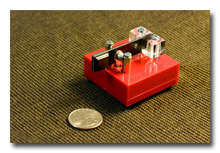 My KX2 came to me with the KXPD2 Attached Precision Keyer Paddle but, having forsaken
dual-lever paddles, I carry the KXPD2 only as an emergency back-up paddle.
My KX2 came to me with the KXPD2 Attached Precision Keyer Paddle but, having forsaken
dual-lever paddles, I carry the KXPD2 only as an emergency back-up paddle.
The paddle I carry in the KX2 Mini Travel Kit to actually use is the very lightweight Whiterook MK-33 single-lever paddle (photo | link). The little Whiterook has a surprisingly good feel, and can be used as a keyer paddle or as a cootie-key, depending on how the KX2 menu is configured.
The Whiterook MK-33 has become my paddle of choice for field operations and I have one in most of my various field-kits.
I have purchased, but have not yet built, a KX Mini Single-Lever Paddle from QRPBuilder.com (link). Once built, this paddle is likely to replace the Elecraft KXPD2 as emergency back-up paddle.
-
The KX2 has a built-in speaker but for those occasions when I want to copy CW through stereo headphones, I carry a pair of iHip-brand ($5 at Big Lots) shoestring-lead earbuds in the KX2 Mini Travel Kit. These sound good and might just be rugged enough to last more than a few outings.
For CW-copy and logging, I carry a pair of Baile "ecofriends" 2.0mm drafting pencils and a Pentel drafting eraser in the KX2 Mini Travel Kit. I log onto half-page log-sheets on a vintage 6"x9" aluminum pilot's knee-board. The aluminum clipboard does not fit inside the Nova 1 bag but could, in an emergency, could be slipped into the bag's rear zipper-pocket.
Using Adobe Acrobat and an available duplex printer, I printed the KX2 Owner's Manual in half-size "booklet" form. This booklet fits nicely in the outside rear pocket of the Nova 1 bag.
For emergency repairs, the KX2 Mini Travel Kit includes a pair of wire cutters, a pair of small screwdrivers, and a roll of black electrical tape.
-
The carrying case is a repurposed LowePro Nova 1 camera bag.
This well-padded and rugged bag accommodates the KX2 transceiver, the second battery, two keys, earbuds, antenna(s), cables, pencils, a QRP dummy load, a Rite in the Rain #935 3"x5" memo-pad, and other items. While not fully waterproof, the bag should provide sufficient protection for the KX2 while in transport in all but the heaviest rain.
-
I built the KX2 Mini Travel Kit to encourage me to engage in human-powered-transport field operations.
With its removeable shoulder strap in place, the Nova 1 is easy to carry over a shoulder for walks or hikes. With the strap removed, the Nova 1 can be easily attached to my bicycle for bicycle-portable operations.
Biking-
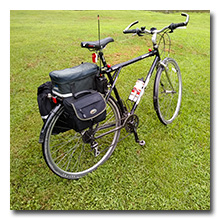 Long ago, when I had originally used a different LowePro Nova 1 as a camera bag, I had
built an easy-to-mount, easy-to-remove, rear-rack-fixture for my bicycle to allow me to
safely carry an SLR camera on the bicycle. This same fixture now allows me to safely
carry the KX2 Mini Travel Kit on the bicycle. A pannier mounted on the other side
of the bicycle can be used to carry a clipboard with copy-paper and logsheets, a hat for
protection against the sun, and a towel1.
Long ago, when I had originally used a different LowePro Nova 1 as a camera bag, I had
built an easy-to-mount, easy-to-remove, rear-rack-fixture for my bicycle to allow me to
safely carry an SLR camera on the bicycle. This same fixture now allows me to safely
carry the KX2 Mini Travel Kit on the bicycle. A pannier mounted on the other side
of the bicycle can be used to carry a clipboard with copy-paper and logsheets, a hat for
protection against the sun, and a towel1.
The aforementioned Goture Red Fox Super Hard 720 carbon-fiber telescoping fishing pole straps nicely to the bicycle's top-tube for transport and, once at the operating site, the pole can be strapped vertically to the bicycle, allowing the kickstand-equipped bicycle to serve as a stable tripod for the mast.
Bicycle-portable operations I've performed using the KX2 Mini Travel Kit include...
- Strouds Run State Park on 2025-09-28.
- Strouds Run State Park on 2025-09-17.
- Strouds Run State Park on 2025-08-03.
- Strouds Run State Park on 2025-06-21.
- Bald Head Island on 2025-05-07.
- Strouds Run State Park on 2025-04-19.
- Strouds Run State Park on 2024-07-06.
- Strouds Run State Park on 2024-06-16.
- Strouds Run State Park on 2024-05-26.
- Lake Alma State Park via Wellston Bike Path on 2024-05-122
- Lake Hope State Park via Moonville Rail Trail on 2024-04-27
- Strouds Run State Park on 2024-04-20
- Strouds Run State Park on 2024-03-29
- Lake Hope State Park via Moonville Rail Trail on 2023-11-04 (with Theo-dog)
- Strouds Run State Park on 2023-10-25
- Strouds Run State Park on 2023-10-12
- Strouds Run State Park on 2023-10-11
- Strouds Run State Park on 2023-10-05
- Strouds Run State Park on 2023-10-04
- Strouds Run State Park on 2023-09-15
- Strouds Run State Park on 2023-09-14
- Strouds Run State Park on 2023-09-04
- Strouds Run State Park on 2023-08-18
- Strouds Run State Park on 2023-08-13
- Strouds Run State Park on 2023-08-12
- Strouds Run State Park on 2023-08-06
- Blennerhassett Island State Park on 2023-07-30 (with Theo- and Ginny-dog)
- Strouds Run State Park on 2023-07-21
-
The removable shoulder strap on the LowePro Nova 1 allows easy transport of the KX2 Mini Travel Kit while traveling by foot. A lighweight backpack can be used to carry additional items such as a clipboard with paper and logsheets, the Goture Red Fox Super Hard 720 carbon-fiber telescoping fishing pole and stake, a hat for protection against the sun, and a towel1.
Trail-hikes I've made while carrying the KX2 Mini Travel Kit include...
- Fort Fisher State Historic Site on 2025-05-05.
- Potawatomi State Nature Preserve, Trail 3, on 2025-03-14
- Gross Memorial Woods State Nature Preserve on 2024-05-20
- Strouds Run State Park, Hickory Trail, on 2023-10-15 (with Theo-dog)
- Rockbridge State Nature Preserve, Natural Bridge Trail, on 2023-10-01
- Natural Bridge State Park, The Original Trail, on 2023-09-24
- Strouds Run State Park, Chestnut Trail, on 2023-07-15 (with Theo-dog)
- Clear Fork Gorge State Nature Preserve, Hog Hollow Trail, on 2023-07-09
-
If I get to the point that I want to do canoe- or kayak-portable operations with the KX2 Mini Travel Kit, since I don't trust myself to not roll the canoe or kayak into the water, and since I don't trust the Nova 1 bag to protect the KX2 in the case of such a dunking, I'll get a high-quality, 100% waterproof, "dry-bag", or perhaps even an appropriately-sized Pelican Case, to place the KX2 Mini Travel Kit in for protection.
-
Footnotes:
[1] "A towel, (the Hitchhikers Guide to the Galaxy) says, is about the most
massively useful thing an interstellar hitchhiker can have. Partly it has great practical value — you
can wrap it around you for warmth as you bound across the cold moons of Jaglan Beta; you can lie on it on
the brilliant marble-sanded beaches of Santraginus V, inhaling the heady sea vapours; you can sleep under
it beneath the stars which shine so redly on the desert world of Kakrafoon; use it to sail a mini raft down
the slow heavy river Moth; wet it for use in hand-to- hand-combat; wrap it round your head to ward off
noxious fumes or to avoid the gaze of the Ravenous Bugblatter Beast of Traal (a mindboggingly stupid animal,
it assumes that if you can't see it, it can't see you — daft as a bush, but very ravenous); you can wave
your towel in emergencies as a distress signal, and of course dry yourself off with it if it still seems to
be clean enough. More importantly, a towel has immense psychological value. For some reason, if a strag
(strag: non-hitch hiker) discovers that a hitch hiker has his towel with him, he will automatically assume
that he is also in possession of a toothbrush, face flannel, soap, tin of biscuits, flask, compass, map,
ball of string, gnat spray, wet weather gear, space suit etc., etc. Furthermore, the strag will then
happily lend the hitch hiker any of these or a dozen other items that the hitch hiker might accidentally
have 'lost'. What the strag will think is that any man who can hitch the length and breadth of the galaxy,
rough it, slum it, struggle against terrible odds, win through, and still knows where his towel is is
clearly a man to be reckoned with." — Douglas Adams, The Hitchhiker's Guide to the Galaxy
[2] I didn't know it at the time, but this was the day after a G5 solar storm, the biggest storm since 2003. Solar numbers were improving but the 15m through 40m bands remained completely dead. Zero QSOs were made.
